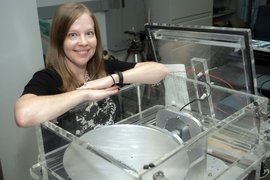Many startups tailor their first product or service to a specific market segment in order to validate their ideas and get some early traction. Far fewer develop a solution to such a fundamental problem that they explore several markets simultaneously, but ClimaCell has done just that.
The problem the company is tackling is weather modeling. Its solution uses the ubiquitous tools of the wireless world, such as the communication networks of cell phones and “internet of things” devices, to create “virtual sensors” capable of tracking and predicting weather in ways traditional sensors, such as satellites and radar, cannot.
ClimaCell’s software, called HyperCast, works by tapping into communications network infrastructure. As devices wirelessly communicate, their signals are affected by precipitation. These effects are imperceptible when we send a text or stream a video, but ClimaCell uses sophisticated modeling algorithms to analyze the signal disruptions and classify the ground-level weather in that location.
“We’re saying something that is on one hand really quite simple, but on the other we think is quite brilliant,” says ClimaCell chief strategy officer Rei Goffer MBA ’17, who co-founded the company in 2015 with Itai Zlotnik MBA ’17 and Shimon Elkabetz. “A lot of the things around us actually sense the weather, just not by design. They’re affected by the weather, and by looking at how they’re affected you can actually reverse engineer things and see through that.”
The result is the most dense network of weather sensors in the world, capable of tracking the weather in every 500-meter space of the Earth’s surface. HyperCast can also generate forecasts that run on graphics processing units (GPUs) to incorporate the latest information and update every minute.
Barely three years old, ClimaCell is being used by leaders in fields including energy, utilities, insurance, and financial services. Its customers include aviation companies such as JetBlue and Delta, on-demand transportation companies like Via, and companies involved in construction like NESCO and Autodesk. ClimaCell is also moving aggressively into the consumer space: The company just released a “skill” for Amazon’s Alexa, and a HyperCast consumer app is being released in 2019.
Goffer admits the founders have been surprised by the company’s rapid rise, but he says they’ve known for a while now that they could create a powerful solution if they could just get access to the right data.
An idea worth pursuing
The founders grew up in Israel and served for several years in the Israeli military, which Goffer says exposed them to some of the latest weather monitoring technologies available. That experience got them thinking about how signals from wireless devices could be used to create a new system for weather modeling, but they knew they needed more skills to build and run such a high-tech company.
Goffer began taking classes at MIT’s Sloan School of Management in 2014. Zlotnik joined him the following year. Elkabetz attended Harvard Business School. As they pursued their MBAs, the founders stayed up to date on the latest developments in weather monitoring — a task made easier by attending MIT.
“The opportunity to interact with faculty members, not just at Sloan but also in our domain of atmospheric sciences, and to be as close as possible to the science and state-of-the-art research, was unique,” Goffer says. “And we’re still very engaged with MIT faculty and research coming out of MIT. This stuff is really cutting edge, and if you’re not [based at] an institution like MIT, your chances of being on top of it are very low. For us, as a young company, being at the cutting edge is really important, otherwise you won’t have an advantage.”
The founders incorporated ClimaCell in 2015, but they continued taking classes and tinkering with their idea. In 2017, Goffer and Zlotnik began a fellowship with MIT’s Legatum Center for Development and Entrepreneurship, which helped them get in front of potential partners and investors. Things have moved quickly since then.
“Up until September of 2016, we were three people with a PowerPoint presentation,” Goffer says. “So that’s two years ago compared to today, where we’re 70 people with $68 million in funding. The journey since we got funded has been quite rapid, faster than we anticipated.”
ClimaCell's relationship with MIT has helped it hire a strong team as it has scaled. The founders say Chief Scientist Daniel Rothenberg PhD '17 has made some particularly valuable innovations. ClimaCell has explored different applications for its technology with a distributed organizational structure that gives employees a lot of independence and authority to expand into different fields. The company also partners with large firms in various industries to quicken their progress in that market. For example, Ford and National Grid serve as strategic investors, helping ClimaCell navigate through the mobility and energy spaces, respectively.
The founders hope success in places like the U.S. will help them make an impact in developing countries. Along with their forthcoming app, ClimaCell is developing a flood prediction solution to help vulnerable communities improve flood alerts.
“There’s this huge market failure where the most weather-sensitive communities around the world actually get access to the poorest-quality weather data,” Goffer says. “People in developing countries have less physical protection and less financial protection like insurance, their economies are much more reliant on agriculture, and their agriculture is much more rain-fed than most places. Put all that together and you get this huge discrepancy between how sensitive these people are to the weather versus their weather data today.”
As ClimaCell’s founders continue to chart their course of expansion, Goffer is convinced that by using wireless signals in this novel way, they’ve unlocked a sea of possibilities.
“The biggest challenge for us is there’s just a huge amount of opportunities,” Goffer says. “Weather is a very horizontal problem. It affects every industry in every market of the world, every sized business, and even consumers. So for us, when you’re bringing something that’s so unique and disruptive to something so fundamental, the biggest question is where do we go next.”









